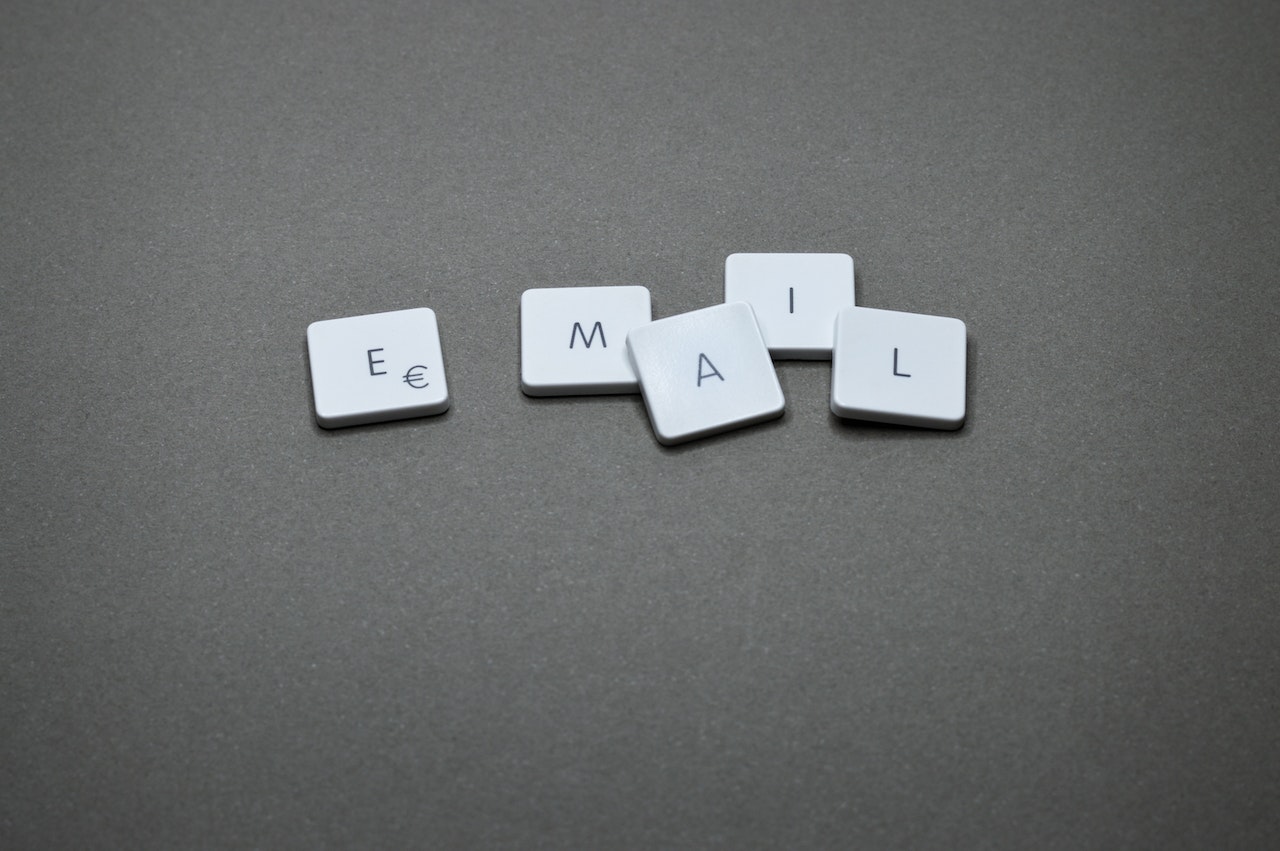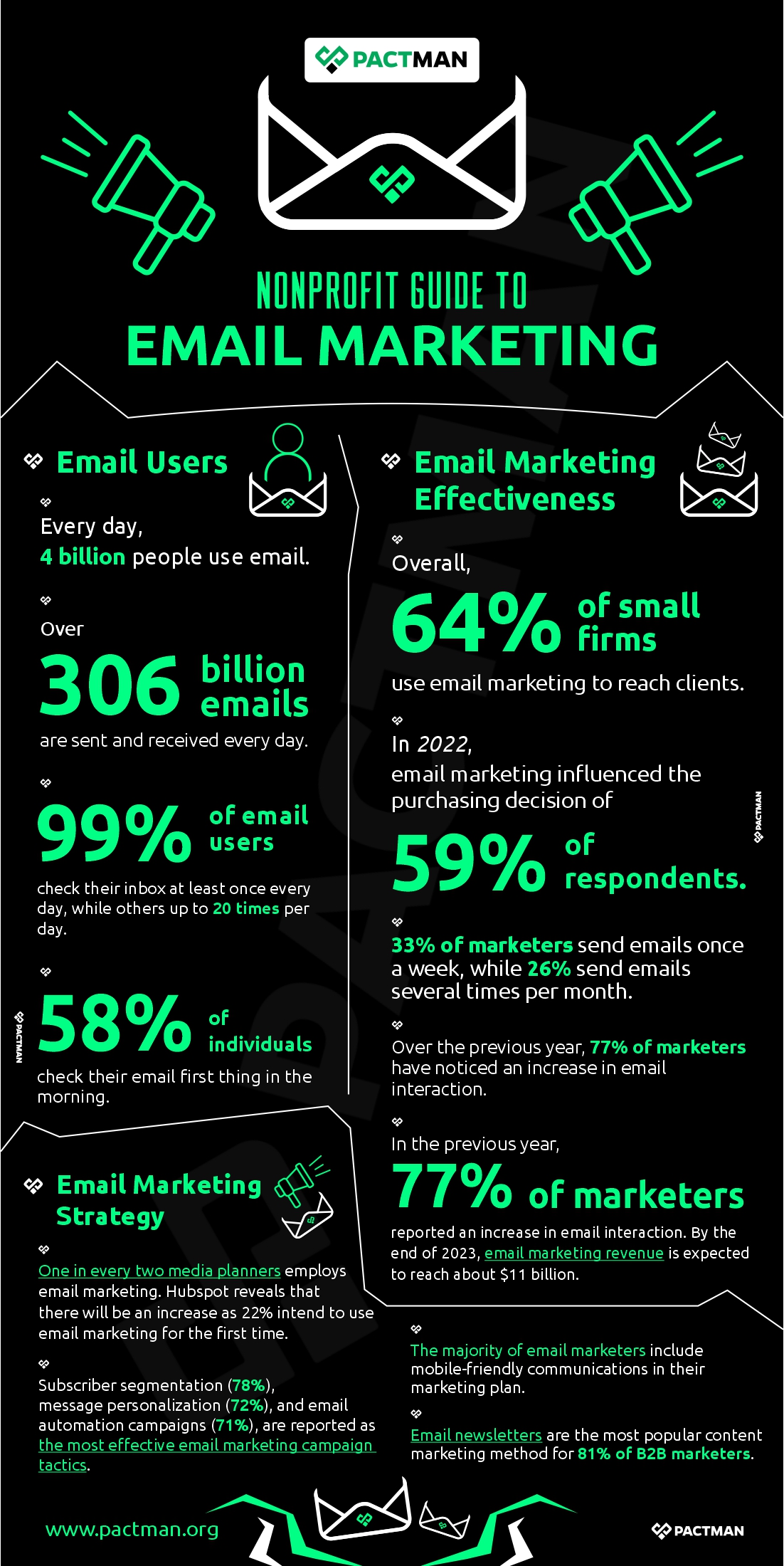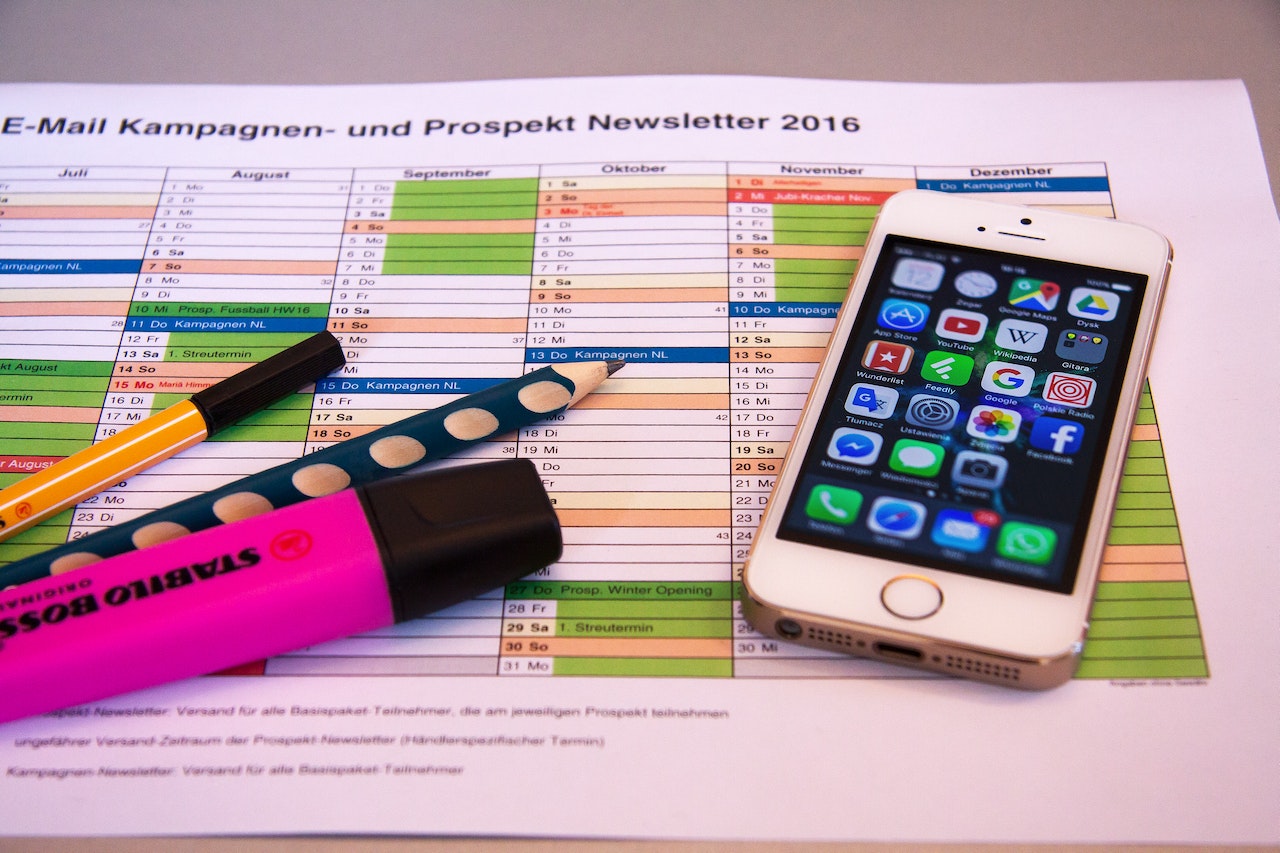I
Introduction
Email marketing has completely transformed corporate communications. Entrepreneurs are no longer at the mercy of the post office. Not to mention, organizations can keep on with business communication outside of the office. By and large, email communications have opened up effective marketing opportunities and have created an effective channel for corporations to maintain internal communications. Hence, companies can experiment with email to achieve important goals and improve business efficiency.

With email marketing, nonprofits can achieve the goal of walking their clients from one stage of the “value journey” to the next. As the audiences follow this path, their lifetime value rises, bringing earnings and stability to your organizations.
II
What is Email Marketing
Email is considered a standard form of digital communication. It is nonetheless one of the most powerful digital marketing options for organizations. Email marketing is a marketing strategy used by organizations to deliver promotional content to a large number of clients. It is often used to create sales through the distribution of promotional offers, the nurturing of leads, or the expansion of the reach of content marketing activities.

Email marketing provides an effective channel to promote an organization’s products and services while also incentivizing client loyalty. In addition, organizations can educate clients on the values of their brands or keep them engaged in the interim.
Email has been a popular marketing technique for businesses because it encourages the user to take action. Likewise, an email will remain in the inbox until it is read, deleted, or archived.
Nonprofits can leverage email marketing to grow audience relationships and drive traffic to the organization’s blog or social media channels. You can also segment your emails and target users by demography to ensure that you only send people the messages they want to see.
III
Email Marketing Statistics Worth Considering
Email remains an extremely successful channel to drive donations and purchases. Not to mention, the platform provides the highest ROI of any marketing activity. In this chapter, we will consider some of the most notable email marketing statistics worth knowing.

Every day, 4 billion people use email. Also, over 306 billion emails are sent and received every day. 99% of email users check their inboxes at least once every day, while others, nearly 20 times per day. In addition, 58% of individuals check their email first thing in the morning.
Overall, 64% of small firms use email marketing to reach clients. In 2022, email marketing influenced the purchasing decision of 59% of respondents. 33% of marketers send emails once a week, while 26% send emails several times per month. Over the previous year, 77% of marketers have noticed an increase in email interaction.
One in every two media planners employs email marketing. However, Hubspot reveals that there will be an increase as 22% intend to use email marketing for the first time. Subscriber segmentation (78%), message personalization (72%), and email automation campaigns (71%), are reported as the most effective email marketing campaign tactics.
In the previous year, 77% of marketers reported an increase in email interaction. By the end of 2023, email marketing revenue is expected to reach about $11 billion.
The majority of email marketers include mobile-friendly communications in their marketing plan. Also, email newsletters are the most popular method of content marketing for 81% of B2B marketers.
IV
Types of Email Marketing
Email marketing has existed for quite a long time compared to other digital marketing tools. Over time, the platform has evolved and changed, but it has remained effective and even grown in popularity over the years.
In this section, we will consider the various forms of email marketing and their effectiveness.

a. Email Newsletters
Email Newsletters are quite popular among companies as it is one of the most effective ways to reach subscribers. Companies often distribute newsletters on a weekly, biweekly, or monthly basis.
Also, small nonprofits can leverage email newsletters to deliver valuable information and resources to subscribers. Not to mention, they are an excellent way to engage with your audience and keep them up to date on your organization’s activities.
Organizations seeking to establish a strong relationship with readers, donors, and volunteers can opt for email newsletters as an email marketing strategy. Writing an effective newsletter allows you to establish a list of interested subscribers who want to hear from your organization. Hence, make sure you’re offering great content that readers are interested in. Remember, an email newsletter will only be as effective as its content.
b. Transactional Emails
Transactional emails are probably one of the least glamorous but most effective types of email marketing. Essentially, they are sent to aid an expected transaction between a sender and a recipient. By and large, the transaction context differs.
A transactional email is intended to inform the donor of their recent activity. As a result, they contain user-specific material and are normally sent one at a time to people.
Nonprofits rely on transactional emails to engage with individual donors. Often viewed as “set it and forget it” notifications that website and product owners deploy, this email strategy tends to have a greater impact on donor experience and retention.
c. Promotional Emails
Promotional Emails are an excellent method to increase sales, signups, and new product offerings. For nonprofits, the basic purpose can be to persuade your audience to donate. Hence, it is best to craft your message in a way that encourages readers to hop on the specific action you intend them to make.
To perfect the mix, utilize promotional emails to reward active subscribers with unique offers or services. Promotional emails, as opposed to transactional emails, typically serve the objective of converting subscribers into clients and clients into brand evangelists.
When done right, this form of marketing may assist an organization in generating revenue as well as increasing donor retention and engagement. As a result, the content and style of a promotional email should be centered on persuading the receiver to act within a certain time frame.
d. Retention Emails
According to Smart Mail, retention emails are personalized and prompted messages delivered to an existing client to promote engagement, loyalty, and satisfaction. It contributes to repeat transactions. Consider Retention Emails for your nonprofit if you have previous expertise with email marketing campaigns.
Likewise, your nonprofit can keep the channels of communication open by sending a message asking for feedback or making an offer to subscribers who haven’t connected with your organization or email campaigns in a while. Retention emails are an effective email campaign strategy for keeping your hard-won donors and readers.
Client delight and engagement are what generate donor retention. It is advantageous to retain donors! Email marketing is the most effective medium for retention. A proactive donor retention email approach is simply a smart approach. Once they sign up, subscribe, download, or donate, you want to do everything you can to keep them interested in your organization. This is accomplished through retention email marketing.
With the expanding rate of the email marketing market, organizations can no longer afford to ignore email marketing. Likewise, nonprofits must seek ways to leverage email marketing to establish and maintain donor relationships and boost the organization’s growth.
V
Effective Approach to Email Marketing
Constant Contact reports that the average ROI for email marketing is $42 for every $1 spent. Needless to say, email is a vital component of any marketing plan, and its effectiveness is heavily dependent on how well you organize your email campaigns.

In this section, we will consider some of the most effective ways for your nonprofit to engage in email marketing.
a. Personalize your message
Your email marketing efforts should embody your reader’s interest. Also, to effectively capture your audience, let your messages sound personal to each person. There are software tools that can help you achieve this goal which we will discuss in the next section.
Knowing the information your readers want allows you to send promotions to email subscribers who desire them rather than sending a generic email.
Organizations must establish a robust email list to spread the word far and wide for email marketing to be productive and generate greater revenue. Fortunately, there are numerous methods for accomplishing this, whether through the low-tech approach of sign-up cards or through donation reminders that direct clients to sign up online. Both approaches are extremely effective in enabling clients to provide information.
b. Understand central and local email marketing
Choose the communications that should be sent via your email marketing platform and the ones to be sent locally. This allows proper traffic to be sent to your sites and enables donors to receive location-specific information. In addition, you can determine how to collect donor email addresses.
Also, include a “Donate” button and social media links prominently in your newsletter. Do the same in the header and footer. Prominently display a “Donate” button as well as your social media icons.
c. Experiment with frequently sending your emails
The Nonprofit Tech for Good Report shows that 68% of organizations worldwide send newsletters. If your organization sends out newsletters quarterly, start sending them out monthly. Increase the frequency of your newsletter from once a month to twice monthly.
Furthermore, according to the 2023 Nonprofit Tech for Good Report, 67% of NGOs only send email fundraising requests quarterly. This is not a good online fundraising strategy. Nonprofits should send email fundraising campaigns at least every month.
d. Keep subject lines short
According to Campaign Monitor, the average open rate and click-through rate for nonprofit emails are 26.6% and 2.7%, respectively. To be above average, your nonprofit must grasp personalization, well-written subject lines, and, of course, post and curate engaging news updates and visual content consistently.
Subject lines can also make or break the open and click-through rates of your email campaign. Firstly, experiment with topic lines using A/B testing, and keep characters to 60 or less. Likewise, subject lines must be brief to prevent being truncated for mobile email clients, as 46% of openings occur on mobile devices.
e. Divide your database into sections
A segmented email list ensures that the appropriate person receives the appropriate information at the appropriate time. While everyone on your email list supports your organization, you do not have to send every email to everyone.
Everyone in your database is at a different point in their relationship with your company, and the emails they get should reflect that. Someone who gave $5 to your organization in the last year, for example, is unlikely to be as active as someone who gave $1,000 to your organization in the last month.
Donation amount, event attendance, and actions done on your website or social media platforms are all crucial measures of engagement level and should not be overlooked.
Also, more involved audience members will generally respond positively to more regular emails, whilst those with fewer touch points should receive fewer emails with more basic information about your NPO.
When consumers download your content or subscribe to your newsletter, make sure you enroll them in a drip campaign that sends them automated emails about the topics they’re interested in.
f. Streamline your email workflow
Every organization understands the value of time, as the saying goes “time is money.” One great way to be efficient in your operations is to leverage automation for some workload. Likewise, email automation can keep your audience engaged while allowing you to focus on other duties.
According to studies, automated emails save hours each week and increase reply and engagement rates by 250%. Essentially, welcome, thank you, and retention emails are the simplest to automate. It is best to put someone through an automated welcome series when they sign up for your email list or donate for the first time. Welcome series emails can garner twice the average open rate of your previous emails, resulting in increased engagement.
Also, thank you emails are another excellent option for automation. Setting up routines to send customized thank-you emails, retention emails, or follow-up emails can be made simple through your database integration. Set the donor on a path to receive another follow-up email showing the results of their donation in a month after they have gotten a thank you email.
It’s easy to create a path and automate an email journey for particular portions of your donor base once you’ve identified some of the ways you want to engage with them.
According to the Global Trends in Giving Report, email inspires 26% of online donors to contribute. Not to mention, email messaging accounts for 15% of all online revenue.
V
Best Email Marketing Tools for Nonprofits
Your organization can save a lot of time and money by automating manual operations with the proper email marketing software. Also, email software tools enhance the efficiency of your campaigns in engaging subscribers and obtaining donations. A good email marketing provider should allow you to build extremely engaging email newsletters with a simple user interface.

In this section, we will consider some of the most effective email marketing tools for nonprofits.
a. MailerLite
MailerLite stands out as one of the most user-friendly email marketing software. This is largely because it offers a drag-and-drop interface that makes creativity in design enjoyable and easy.
With the software tool, organizations new to email marketing will not consider it a hassle to understand how to use the various features. This makes it ideal for nonprofits looking for a clear strategy for email marketing.
MailerLite also offers attractive perks such as a free-for-ever plan with 1,000 subscribers and 12,000 email sends. However, if you require more bandwidth or want more advanced capabilities, you can opt for the premium subscription. The platform allows you to pay monthly or annually, but an annual plan saves you 15%. Also, nonprofits are eligible for a 30% discount.
b. Zoho Campaigns
Zoho Campaigns is one effective software platform for nonprofits. Organizations can leverage their contact management tools to add custom fields to sign-up forms.
Also, Zoho’s contact management capabilities ensure that you record the particular information necessary for donor management. The email marketing platform centralizes all donor information and interactions with your organization.
It’s critical to get to know your donor base and keep their information up to date. This allows you to secure all your contacts in one place and contact donors promptly.
c. Campaign Monitor
The ROI for email marketing campaigns for nonprofits is frequently based on donations rather than purchases. Hence, it is critical to have mechanisms in place to track which efforts have resulted in donations.
The App Store of Campaign Monitor allows you to download add-ons. This is one great way to extend your email marketing ability such as tracking donations through customer relationship management tools like Salesforce and Microsoft Dynamics CRM. This lets you know which email efforts resulted in donations.
Tracking the performance of your email campaigns helps know the effective areas, the ones that need to be improved, and which components may be optimized to improve ROI.
d. SendGrid
SendGrid’s email editor allows you to personalize emails by including any donor information in your message. For example, you can include basic demographic information such as name, age, and location, as well as custom fields such as which charities they support or events they are interested in.
SendGrid automatically retrieves this information from your contact list, eliminating the need for you to enter it manually for each recipient.
If you want your donors and audience to believe you genuinely care about them and aren’t just pursuing their money, you must treat them like individuals, not numbers on a list. Automation is wonderful for saving time, but it must be combined with personalization to guarantee that your donors receive the best service possible.
e. Flodesk
Flodesk, through its email design-builder, has established a reputation that precedes them. You can easily produce stunning emails that appear to have been designed by a graphic designer. Not to mention, these designs can be done super-fast. With their layouts and templates, you can drag and drop attractive designs and then paste your email copy right in there.
Other super features of Flodesk include integration with other nonprofit technology tools, automation and workflow tools, and simple design tools among others.
Email marketing for nonprofits is critical for the smooth operation of an organization. It frees up your time and allows you to focus on other crucial work. To ensure the efficiency of your nonprofit, leverage email marketing tools to your advantage.
Conclusion
Email marketing provides a great way for organizations to be innovative with their communication and grow their donor retention efforts. It’s also a low-cost marketing method that combines convenience and technology.
Most nonprofits today utilize email marketing campaigns to advertise and garner more audiences and donors. Not to mention, it is both cost-effective and precise. Likewise, email is most effective when combined with content and advertising efforts to indoctrinate new subscribers, nurture those relationships, and move them fast through the donor relationship journey.


